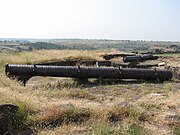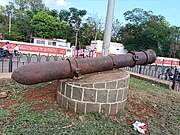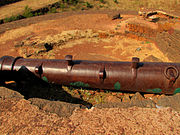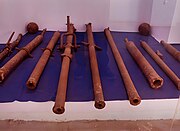Gunpowder weapons in the Bahmani Sultanate
This article needs additional citations for verification. (April 2024) |
The Bahmani Sultanate was the first Indian sultanate to use and invent gunpowder weapons, in 1347. Their firearms were more advanced than those of the Mamluks of Egypt and European kingdoms during the same era. The first recorded use of firearms in South Asia occurred at the Battle of Adoni in 1368. In the Deccan, the Bahmani Sultanate, led by Mohammed Shah I, employed a train of artillery against the Vijayanagara Empire under Harihara II. Due to the efficient artillery of the Bahmani Sultanate, they achieved exemplary victory against the Vijayanagara Empire, which was still using outdated weapons. Gunpowder weaponry, including muskets, hand cannons, cannons, and war mortars, were employed by the Bahmani Sultanate in South India during the 14th to the 15th centuries.[1][2]

Weapons development[edit]

The Bara Gazi Toph holds the title of the longest cannon in the world. It was commissioned by Alaudin Bahman Shah in 1347, showcasing the advanced artillery of the Bahmani Sultanate during its era. Crafted from an alloy known as panch dhatu, it stands as a testament to the technological prowess of its time. Measuring approximately 29 feet in length with a circumference of 7.6 feet, a diameter of 2 feet, and a thickness of 7 inches, the cannon is considerably large. Its top portion has 20 rings, indicating that during wartime, it required the strength of twenty soldiers to maneuver it. Unfortunately, due to neglect and inadequate security measures, only five of these rings remain today. According to photographer Mohammed Ayazuddin, the estimated weight of the cannon is around 80 tons.[3]

Paranda Fort was possibly constructed by Mahmud Gawan. The fort represents an example of military architecture and engineering and served as military base for the Bahmani Sultanate & other Deccan sultanates.[4] In January 1471, Mahmud Gawan, the Wazir (Prime Minister) of the Bahmani Sultanate, utilized heavy cannons and explosive mines to demolish the Fort of Machal. Following the capture of Goa Port from the Hindu Vijayanagara Empire in 1472, Mahmud Gawan dispatched Bahmani agents to Egypt and Anatolia to trade Indian textiles and spices.
The historian Ferishta, highlights the use of cannons during the Bahmani siege of Belgaum in 1472. Similarly, accounts from travelers like Afanasiy Nikitin, Ludovico di Varthema, and Afonso de Albuquerque confirm the deployment of gunpowder weapons during that period. Afonso de Albuquerque noted the remarkable quality of locally crafted guns in the Deccan, surpassing those made by renowned European craftsmen. This recognition speaks volumes about the expertise of Deccan gunsmiths. The Portuguese were impressed to the extent that they sent samples back to Portugal, presumably for further study. They continued to depend on Deccan gunsmiths for their arsenal in Goa, even exporting matchlocks to Japan during the 16th century.
Other gunpowder weapons[edit]
The Bahmani Sultanate also utilized hand cannons, grenades, and muskets.[1] Below are some of their remaining artifacts.
-
Muskets from the Bahmanid era at the Bidar Fort Museum
-
Bahmani's era Cannons in Paranda fort
-
Bahmani and Adil Shahi era Cannons located at Naldurg fort
-
A Bahmani's era Cannon Located at Bidar Fort
-
Another cannon in the Bidar Fort
-
Hand cannons from the Bahmanid era at the Bidar Fort Museum
References[edit]
- ^ a b Roy, Kaushik (2014-05-22). Military Transition in Early Modern Asia, 1400-1750: Cavalry, Guns, Government and Ships. A&C Black. p. 21. ISBN 978-1-78093-813-4.
- ^ Khan, Iqtidar (1981). "Early Use of Cannon and Musket in India: A.D. 1442-1526". Journal of the Economic and Social History of the Orient. 24 (2): 146–164. doi:10.2307/3631993. JSTOR 3631993. Retrieved 2024-04-11.
- ^ YMD (2018-06-12). "World's Longest Cannon in Bahmani Fort". Young Muslim Digest. Retrieved 2024-04-10.
- ^ "Top thing to do in Paranda Fort (2024) | All about Paranda Fort, Osmanabad, Maharashtra". www.tripnight.com. Retrieved 2024-04-10.






